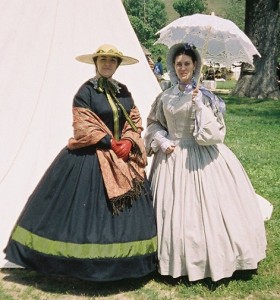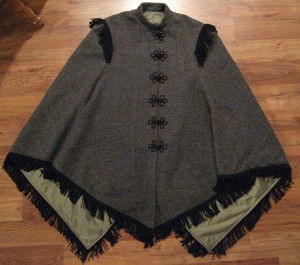
“You’ve made a wool Civil War dress?… For events in Southern California?” I was chatting with a good friend about her new dark gray bodice & skirt with lime silk trimming.
I thought she was nuts for making such a thing. I mean, it didn’t get *that* cold at reenacting events here. But then she reminded me of how the qualities of wool actually kept her comfortable.
Although we saw all the soldiers in their wool trousers and coats, I had never given a thought to using wool for my own historical clothing. Sure, I had modern skirts and coats out of this versatile textile but hadn’t considered the significance in making costumes out of it.
Now, years later, I still don’t have any wool costumes for myself (being in California will do that). However, I have made my husband’s Civil War sack coat and waistcoat, and a Regency tailcoat that turned out divine.

He’s confirmed my wool studies that it actually keeps you cool – naturally. When you sweat (as we all do at hot, sunny events) the wool absorbs the sweat making it damp and getting off of you. When the breeze blows, it creates a nice cooling effect. (Of course, you have to get past those first agonizing minutes until you’ve wetted the whole thing down.)
And wool breathes and lets the hot air between you and the garment out. So that with the absorption of the perspiration it keeps you cool.
And not just for hot weather, being made of the hair that keeps sheep warm, wool keeps you warm for those chilly evenings. Ever hear of using heavy wool blankets in the winter? Yep, it’ll keep you cozy too.
Variety of Wool Fabrics to Choose From
You’ll find dozens of various wool textiles in the marketplace. Although, some weaves are easier to find but will still make you marvelous in that 1894 caroling dress.
For 19th Century projects, stick with the smooth finish fabrics – no fancy weaves or pieces with loops or curls sitting on top, these are too modern looking.
Start looking for:
- Broadcloth
- Merino
- Suitings with smooth surfaces
- Twills
- Checks/Plaids/Tartans/Stripes
- Tropical weight wools – very lovely for day dresses
- Flannel
For those that contain more drape (especially tropical weight and some suitings), you should consider flatlining them with a cotton twill or polished cotton for more body to use for boned bodices.
If you need a more in-depth look at wool as a textile, I HIGHLY recommend Julie Parker’s All About Wool: A Fabric Dictionary & Swatchbook. It is invaluable to your wool projects. Search high & low for it as it has 30 actual wool swatches.
Watch Out for Blended Fabrics

For a special anniversary years ago, my husband & I were in Vermont in October. We wanted to dress in Victorian clothes for an elegant meal at a 19th C.-style restaurant. Well, of course I needed a period coat to go with it all. So I made the Truly Victorian Talma Wrap. I knew I wanted to make it out of wool too.
Years ago I purchased a gorgeous end piece of designer quality black Scottish wool but couldn’t bring myself to cut into it (and still can’t). Especially for something as “trifling” as a bustle coat. So I went shopping.
You’ll find LOADS of wool blends out there. Nowadays it seems most fabrics hocked as wool are blended with polyester or nylon. This keeps the cost down but is terrible for us historical costumers who want 100% natural textiles.
The best way to know what you’re buying is to burn test a few of the fibers. (Not in the store though, silly!) Usually the wool will be running only one direction –either with the grain/selvedge or the crosswise threads. If doing a burn test, pull threads from both directions so you can determine if it’s a blend or 100%.
If you can find wool on bolts with labels, get to know what 100% feels and looks like so you can identify a wool blend easily. The 100% textile will always cost more than a blend. But keep your budget in mind when shopping for wool. It’s ok to use a blend as it really is more accessible both in stores and to your pocketbook.
Where to Buy Wool Online
Get samples if you can. Build up your own swatchbook so you can learn to identify wool and wool blends by their touch. If you’re new to wool, wander around your local fabric store to get an idea of what wool feels like, the textures available and how to care for it.
This is not an exhaustive list, merely places I’ve found over the years that carry wool. I have not purchased from all of the vendors listed here so do proper research before buying.
B.Black and Sons – any kind of wool you want
Burnley & Trowbridge – Tell Angela you found her here!
New York Fashion Center Fabrics
Renaissance Fabrics – Tell Diana you found her here!
If you’ve made a 19th Century wool costume, please post a picture of it with a brief description over on the Facebook page. I can’t wait to see what you’ve made!

Wool suiting, such as for modern men’s suits, is very thin (compared to what we think of as wool) and often doesn’t feel like “wool” –as in “wooly/furry” as it’s all very flat and smooth, seeming more like a blend or synthetic as a result–so do read the labels carefully.
Rebecca, I actually think high quality menswear pure wool suitings, which tend to be much more expensive than much of the women’s fashion stuff, are closer to 19th c. goods. Furry was not a thing to go for in middle or upper classes! The smooth, lustrous, almost silk-like finish, come from the fibers being worsted. Being thin, it can be manipulated in tucks etc without being too bulky, and you can simply use flat lining for stability, as you would for a silk.
Thank you so much for providing such a wonderful look at wool as a textile. I have often gotten these sort of comments when I wear any one of my three wool dresses (I live in Central Texas). I even wear them when it is 90+ with tons of humidity. Wool is such a wonderful textile and really does not get the credit it deserves.
Huzzah for talking about why fibers matter. In older books, wool is simply “cloth.” It was fire-resistant, which made the difference between life and death for women who worked near open hearths.
I’ve been scared to use wool for summer costumes here in Georgia because summer is usually mid 90s, humid, and no breeze. Anyone have experience with wool in hot, humid, non-breezy places? The sweat won’t even evaporate off your skin; would it do so from the wool?
Here’s another wool source in NH
http://www.dorrmillstore.com/
The only time I have ever had problems with wool is during indoor events in winter when the modern centrally heated building is kept to warm.
Polyester is the enemy of reenactors and is the difference between “costume” and “historical clothing.”